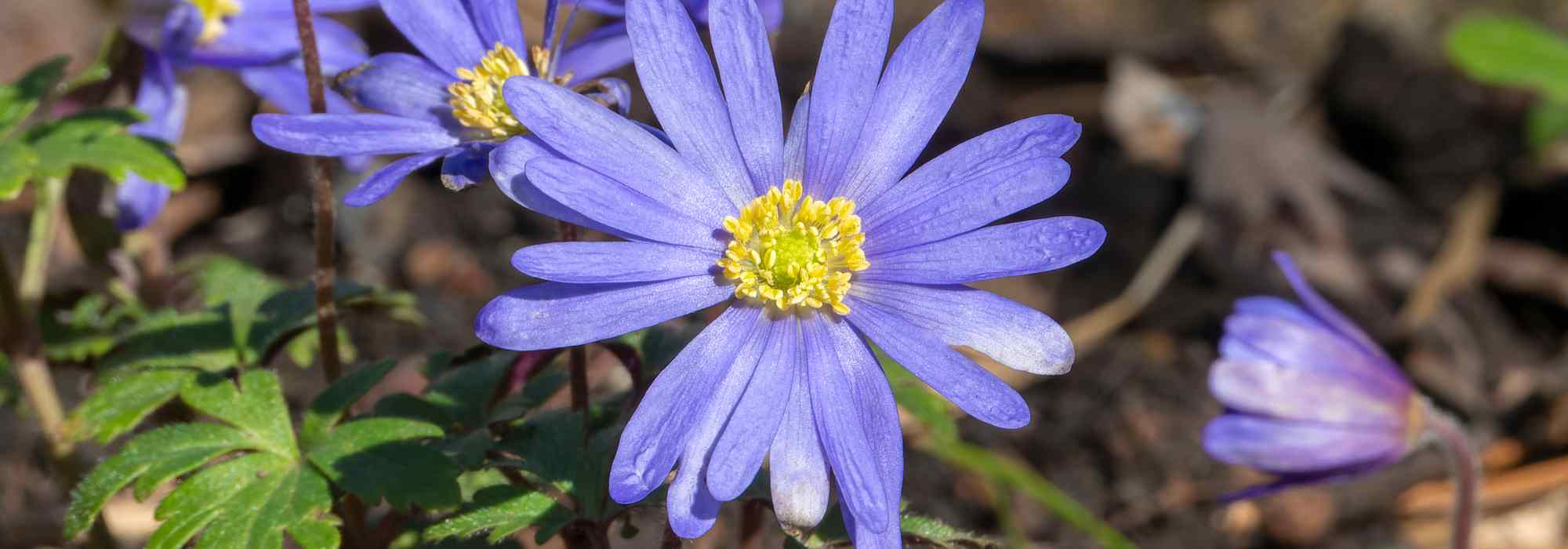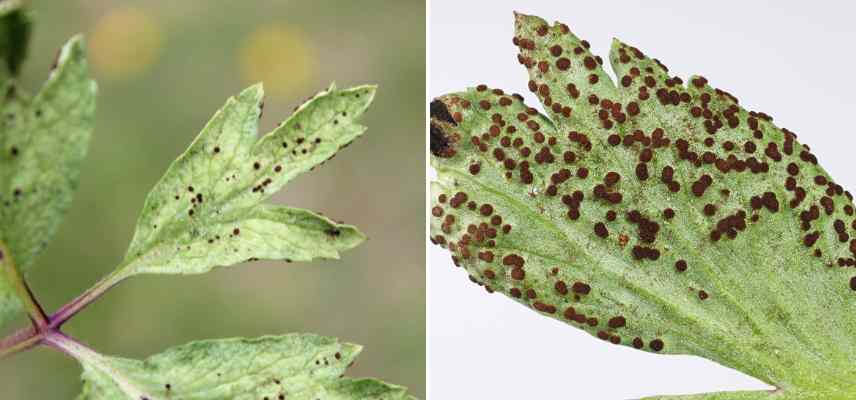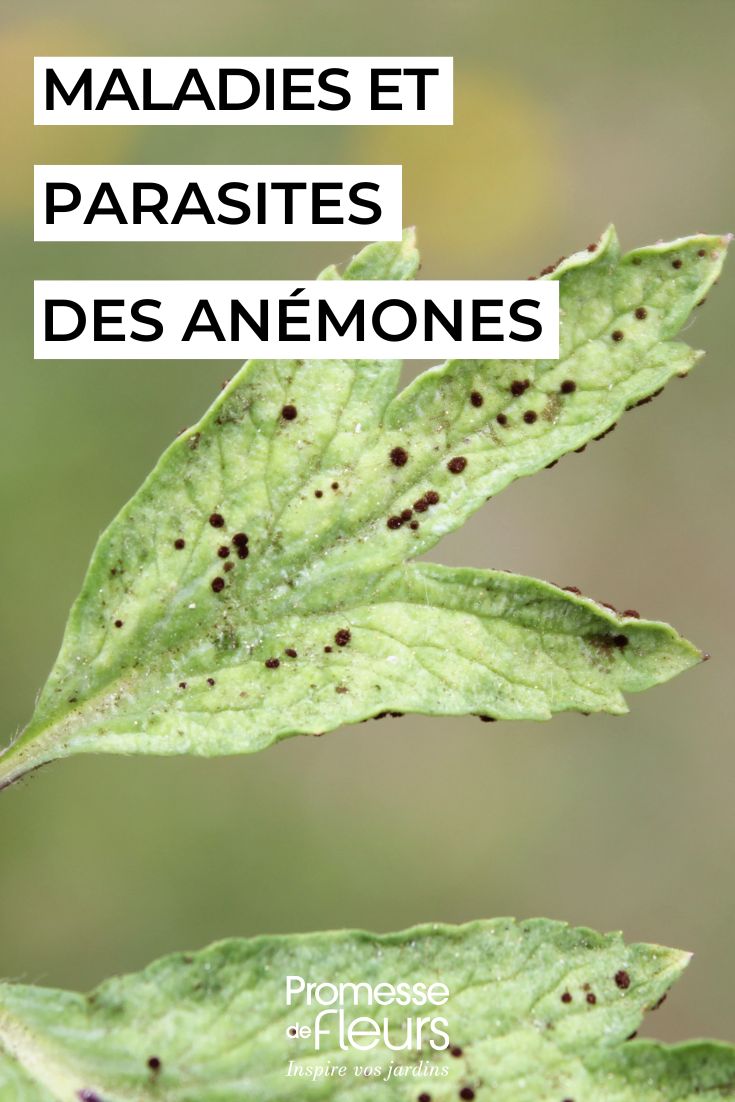
Diseases and parasitic pests of Anemones
Treating fungi and parasitic organisms naturally
Contents
Anemones brighten up mid-spring with their freshness and blue, white, red or pink colours! Wood anemones, Anemones de Caen or Greek anemones, all these charming spring-flowering bulbs are very easy to grow and generally very hardy. But they can sometimes be weakened by a fungus or unwanted pest, such as mildew or slugs.
Here are the few problems that bulbous anemones (or more precisely, cormous anemones) may encounter and how to remedy them.
To learn all about anemones, we recommend our comprehensive guide: Spring anemones: planting, cultivation, care and uses.
Fungal diseases of spring anemones
Downy Mildew
Along with rust, this is the main enemy of spring anemones. It first causes yellowing of the foliage, followed by the appearance of blackish spots.
This fungal disease develops in stagnant moisture and mild temperatures.
- Symptoms : black spots appear on the foliage, soon covered by a whitish down. Flowering is poor or aborted.
- Treatment : spraying with horsetail manure.
- Prevention : ensure your soil is well-drained—bulbs dislike waterlogged soil, which can lead to downy mildew. Add well-rotted compost or leaf mould to improve soil structure. Also, remove all affected parts.
Rust
This is one of the most common diseases in anemones (Tranzschelia discolor). It occurs in warm and humid weather conditions, with alternating rain and sunshine promoting its appearance. Rust deforms the leaves.
- Symptoms : leaves thicken, small orange or brown pustules appear on the underside of the leaves, which eventually become necrotic. Severely affected plants do not flower.
- Treatment : spray with nettle manure, horsetail manure, or garlic decoction on the leaves. Use natural copper-based fungicides. Remove infected leaves.
- Prevention : promote good air circulation. Avoid overcrowded planting and water in the morning rather than the evening.
→ Discover our full guide on rust.

Smut
Smut can also hinder the healthy growth of anemones. This is a disease caused by various fungi also found in Eranthis or Chionodoxa. The most commonly involved fungal genus is Urocystis. Smut spreads rapidly in very humid weather.
- Symptoms : irregular spots and black pustules on leaves and stems, sometimes even flowers. Wilting and yellowing of infected parts. Leaf deformation and stunted growth.
- Treatment : remove and destroy infected plants to prevent spread. Avoid replanting in the infected area for several years.
- Prevention : ensure good air circulation around plants. Avoid excessive moisture and late watering.
Mosaic Virus
Mosaic virus is a viral disease that causes discolouration patterns on leaves, often in the form of yellow or light marbling. It is also referred to as a disease in anemones. It is usually transmitted by insect vectors such as leafhoppers, thrips, or nematodes and can weaken the plant by reducing its ability to perform photosynthesis. Some viral diseases can also be transmitted during bulb division or handling.
- Symptoms: discolouration patterns on leaves.
- Treatment: remove infected plants, as there is no effective treatment!
- Prevention: control insect vectors, maintain good garden hygiene, and avoid introducing infected plants into the garden.
Pests of spring anemones
Three main enemies can target bulbous anemones.
Rodents
As with all bulbous flowers, anemones can fall prey to small garden rodents. It is mainly field mice and voles that may disturb them when digging through the soil in search of food, or moles when burrowing their tunnels.
- Symptoms: bulbs are dug up or damaged.
- Treatment: use chicken wire or bulb baskets to protect bulbs and corms.
- Prevention: plant natural repellents around the flower bed (rosemary, lavender, wormwood…).
→ Discover our tips to deter these rodents in our article on field mice and the one on controlling the water vole or field vole.
Slugs and snails
Gastropods mainly attack Anemone blanda (Greek anemone). As always with these pests, young shoots are particularly vulnerable.
- Symptoms: leaves are holed or partially eaten, with slime trails visible on leaves and soil.
- Treatment: use slug pellets such as Ferramol®. Install physical barriers like crushed eggshells or a thick layer of volcanic rock around plants.
- Prevention: keep the garden tidy by removing plant debris where slugs may hide. Water in the morning so the soil is dry at night, when slugs are most active.
Aphids
Aphids are small, easily recognisable insects, green, black or yellow in colour, which settle and sometimes overrun young shoots, stems and the undersides of leaves. They mainly attack young anemone shoots, deforming and weakening them. By feeding on the sap, they cause stunted growth, yellowing foliage and leaf distortion.
- Symptoms: yellowing leaves, reduced growth.
- Treatment: use natural insecticides like garlic decoction or a soapy water spray (solution of 5 ml black soap diluted in 1 litre of water). An infusion of black soap and garlic can help eliminate them. For severe infestations, use a natural insecticide based on pyrethrum or neem oil to suffocate aphids.
- Prevention: monitor plants regularly. Introduce natural predators like ladybirds or lacewing larvae, which prey on aphids. Avoid excessive nitrogen fertilisers.
→ Learn more: Aphids: identification and treatments.
Nematodes
Nematodes are microscopic worms, invisible to the naked eye, which attack roots and corms. When infested, anemones wilt and eventually die. Nematodes spread mainly through soil and irrigation water but can also be carried by infected bulbs. Warm, humid conditions favour their development.
- Symptoms: wilting of above-ground parts, yellowing leaves, stunted growth, root lesions.
- Treatment: soil solarisation (laying clear plastic sheeting over the area in midsummer to generate intense heat, killing nematodes). Use repellent plants like French marigolds (they contain thiophene, which repels and reduces nematode proliferation). Spray with tansy manure.
- Prevention: avoid overly wet soils.
Our prevention tips for healthy anemones
Spring anemones are rarely affected by diseases or pests. When planting, always inspect your packet of corms to avoid planting infected, soft or mouldy bulbs. A regular inspection of the plants to detect early signs of disease or pests is always recommended, especially in the first few years.
To keep your spring anemones thriving year after year, simply provide them with good growing conditions, as although they are reputed to be easy, they are, like many bulbs, sensitive to moisture and poorly drained soil can often prove fatal. A soil rich in organic matter also promotes healthy growth.
Apart from this small requirement, these delightful flowers require little fuss, bringing colour to flowerbeds and woodland areas with their delicate charm!
→ Learn more in our articles Spring Bulbs: Tips and Advice for Planting Your Collections and All About Garden Soil Drainage.
- Subscribe!
- Contents
































Comments